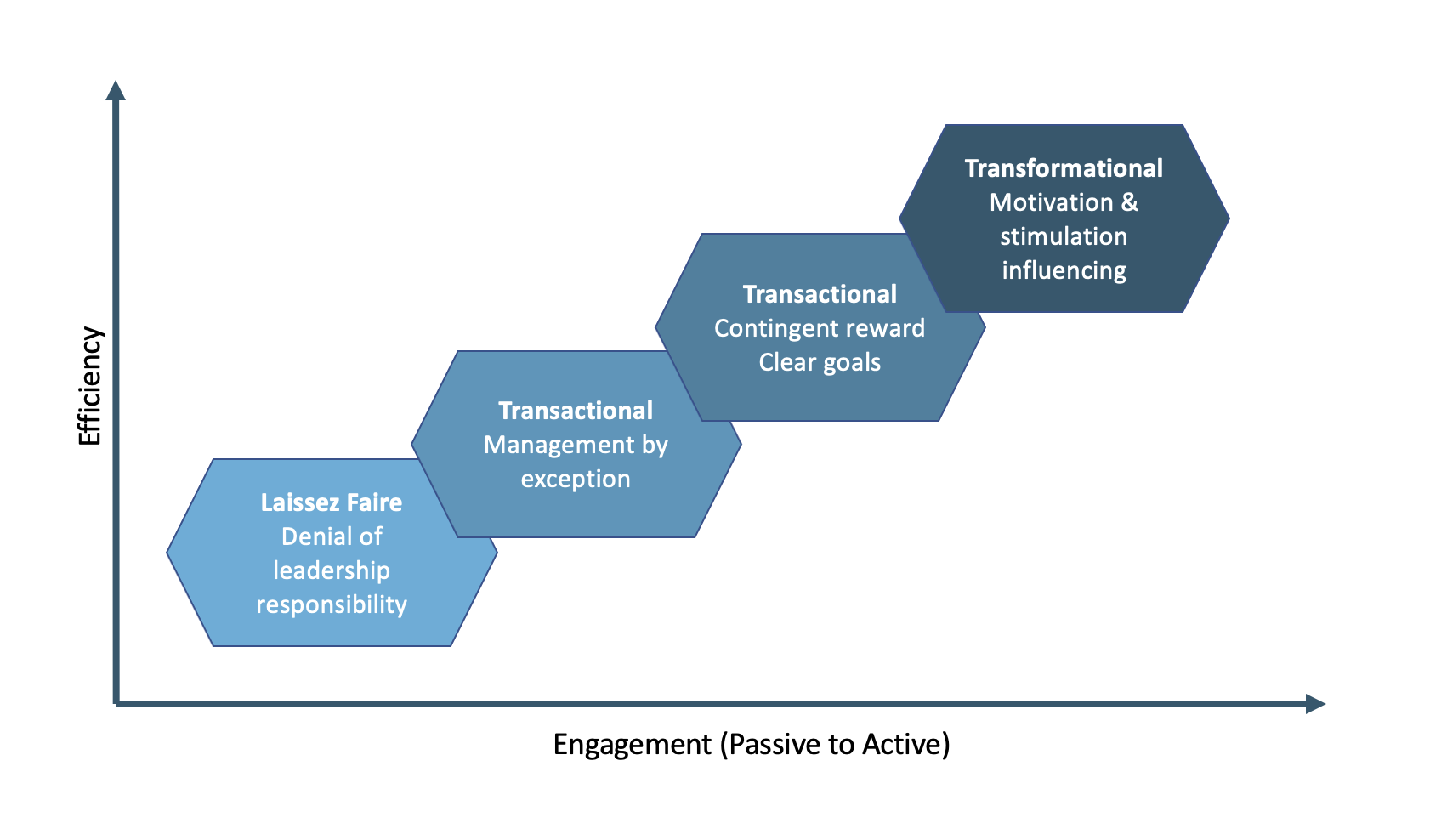
Activity #1
Read the scholarly paper by Giltinane CL. (2013). You will gain an impression of the major types of leadership concepts and theories, and you will review evidence to support their influence on health outcomes.
Leadership Theories and Concepts
Leadership is a universal concept studied and applied in many disciplines, including psychology, education, military, management, healthcare, and nursing. All conceptualizations of leadership have four elements in common: leadership is (a) a process, that (b) involves influence, and (c) occurs within a group setting or context, and (d) is concerned with achieving goals that reflect a shared vision (Cummings et al., 2018).
Leadership styles are generally categorized as focusing on either human relationships or task completion (Cummings et al., 2018). Relational leadership focuses on people and relationships; examples include transformational leadership and authentic leadership. The best-known task-focused leadership style is transactional contingent reward leadership, in which leaders provide rewards in exchange for tasks completed. When leaders are absent and uninvolved, they are known as laissez-faire leaders.
A popular leadership theory, the Full Range Theory, was developed and tested by two organizational psychologists in the 1990s (Bass & Avolio, 1994). Full Range Theory is depicted in Figure 1 as having two axes: efficiency (task-oriented Y axis) and engagement (relationship-oriented X axis). Effective leaders must be able to address both efficiency and engagement in complex work environments. Fortunately, skills related to efficiency and relational leadership styles can be developed over time.
Figure 1. Full Range Theory
Table 1. Characteristics of Full Range Theory Leadership Styles
| Leadership Style | Chief Characteristics |
| Transformational |
|
| Transactional
Contingent Reward (Active management) |
|
| Transactional
Passive management (Management by exception) |
|
| Laissez-faire leadership
(Non-leadership) |
|
Transformational leaders
Transformational leaders have four chief characteristics, although individual leaders may have different combinations of these four characteristics. The first two characteristics, idealized influence and inspirational motivation, are also known as charisma or charismatic leadership. These leaders are able to captivate and motivate large groups of followers by sharing their ideals and visions in a way that is meaningful and inspirational. The other two transformational leadership styles, individualized consideration and intellectual stimulation, work well with small groups or 1-on-1.
Transactional leaders
Transactional leadership is task-focused but very important. The first kind of transactional leader is the contingent reward transactional leader. These leaders are effective managers. They know how to carry out tasks efficiently by establishing work-related rewards (contingent rewards) where workers know exactly what they need to do to meet their work requirements. Workers know that if they carry out their part of the work (contract), their leader will follow through with a contingent reward. Transactional leadership also includes a passive and ineffective leadership style known as management by exception, where the leader only steps in when a problem arises. Reactive management jeopardizes goal completion, introducing delays and waste of resources and staff time and energy. Cummings et al. (2018) explain the importance of transactional leadership on pages 50-51 (under 4.1 and 4.2 Implications).
Laissez-faire leaders
These non-leaders are rarely seen or heard; in fact, some staff may never have met them or know who they are.
Effective Leadership Styles for Complex Healthcare Settings
In complex work environments, the most effective leaders use both transformational and contingent reward transactional leadership styles (Judge & Piccolo, 2004).
The transformational style (i.e., relationship-focused) appeals more to nurses and has a bigger impact on healthcare outcomes than the transactional or task-focused approaches (Cummings et al., 2018). Nurse, work environment, and organizational outcomes, are categorized under five themes: (1) staff satisfaction with work, role and pay, (2) staff relationships with work, (3) staff health and wellbeing, (4) work environment factors, and (5) productivity and effectiveness.
Although contingent reward transactional leadership/effective management is important for a smooth-running organization/department/unit, nurses are most influenced by the quality of relationships they have with their leaders.
Wong et al. (2013) conducted a systematic literature review with a specific focus on leadership styles and their impact on patient outcomes. You’ll notice that the researchers used Donabedian’s Structure, Process, Outcome (SPO) framework to help organize their literature review findings (See page 711). In this framework, Structure (S) is the predominant leadership style, characterized as relational or task-based. Process (P) represents leadership processes or actions such as team building. Outcomes (O) are measurable patient outcomes, including mortality and adverse events (e.g., falls with injuries). In this framework, there are links between S, P and O. Effective leadership styles (S) are needed to carry out effective leadership processes (P) to produce intended, positive patient outcomes (O). Leadership, therefore, is the driver for successful actions and outcomes. The three measurable patient outcomes were patient satisfaction, patient adverse events (e.g., hospital acquired infections), and mortality. Looking at the causal links between P→O, when key processes were in place (e.g., increased staff expertise and collaboration), adverse events and mortality decreased, and patient satisfaction increased.
Activity #2
Before continuing with this section, please read the paper by Avolio & Gardner (2005) on authentic leadership.
Authentic Leadership
Authentic leadership is like a plant’s tap root with lots of other roots or styles growing from it, to strengthen and to nourish the plant’s growth and development. As you begin developing your unique leadership style (e.g., a blend of effective task and relational styles), you need to begin with authentic leadership. For many years, leadership development focused on transformational and transactional styles. Around 20 years ago, leadership researchers realized that effective transformational leaders with no morals or ethical principles could be quite dangerous. Just because a leader has a vision and can inspire followers, does not mean that the vision is appropriate or just.
Authentic leaders are “those who are deeply aware of how they think and behave and are perceived by others as being aware of their own and others’ values/moral perspectives, knowledge, and strengths; aware of the context in which they operate; and who are confident, hopeful, optimistic, resilient, and of a high moral character” (Avolio & Gardner, 2005, p. 321). Authentic leaders demonstrate emotional intelligence through a moral/ethical lens: they are aware of their own values and ethics; they regulate their own emotions for the greater good; they are aware of others’ values and ethical standards; and they actively promote others to behave in moral and ethical ways for the greater good. Authentic leaders are open, transparent, and genuine/not fake. They build on others’ strengths, and they consider the glass to be “half full.” Of note, appreciative inquiry is a positive psychology approach commonly used by authentic leaders. If you want to learn more about appreciative inquiry, watch this short video by Ton Townsin (2013).
Video: Appreciative Inquiry (3:46)
Learning Activity: Critical Reflection on Your Own Leadership Style
At this point, pause and reflect on your leadership style. Think about your personal and professional qualities and skills with respect to transformational, contingent reward transactional, and authentic leadership styles. Create a table like the one below of the qualities you have that characterize each leadership style. You probably already possess many leadership assets and positive qualities—fill in your personal leadership table to see which ones you have—and build on them.
My Leadership Table
| Characteristics | Transformational | Transactional-CR | Authentic |
There are many other leadership styles that you can read about, such as resonant leadership, quantum/complexity leadership, and servant leadership; however, all leadership styles fall within two main categories: relational or task-based.
Activity #3
Before continuing and if you have access, please read the paper by Roberts et al. (2005) on Reflected Best-Self.
Becoming Authentic
One way to become an authentic leader is to create and refine your “Reflected Best-Self.” Roberts and colleagues (2005) describe a Reflected Best-Self as “being extraordinary” and “at one’s best self”. The authors believe that through a Reflected Best-Self exercise, you create a pathway to becoming extraordinary; “you envision the self at one’s best and then act upon this vision to translate possibilities into reality”.
Learning Activity: Reflected Best-Self (RBS)
Imagine that others are a mirror for you: their verbal and non-verbal reactions to your words and behaviours provide great feedback to you. Think of a recent interaction with colleagues, classmates, or even friends and family, and consider the following questions:
- If their responses were positive, what did you do or say to elicit their positive responses towards you?
- If their responses were negative, what did you do or say to elicit their negative responses towards you?
- Planning your next interaction with this individual or group of people: What will you do and say to build on your positive words and behaviours, while minimizing your negative words and behaviours?
Over time, your capacity to reflect your best self will become more natural and reflexive.
You may want to keep a journal of your reflections, perhaps once weekly. When making a journal entry, pick an interaction to deconstruct based on the questions above. You can also review an interaction by going through the questions with a peer confidante or mentor—someone you trust to give you honest, constructive feedback on how to optimize your positive words and behaviours while minimizing negative ones. We encourage you to do the following: keep a self-reflection journal where you commit to record and analyze at least one group interaction a week, and select a peer confidant or mentor/coach who is trustworthy and will provide you with constructive and supportive feedback. These techniques are well-established as the most effective ways to pursue authentic leader self-development.
Activity #4
Before moving on, download the Registered Nurses’ Association of Ontario (RNAO) guideline: Developing and Sustaining Nursing Leadership on the RNAO’s website. Read pages 16-22; 27-57.
Common Leadership Practices
This conceptual model developed by the RNAO focuses on transformational leadership development for all nursing roles and at all organizational levels (e.g., point of care, educator, unit leader, manager, executive officer or director). According to this model, organizational supports (e.g., cultural climate) and personal resources (e.g., professional identity, individual attributes) contribute to the development of effective leadership practices. Effective leadership practices (all roles, all levels) influence healthy outcomes for patients and their families, nurses and their teams, and the organization.
Learning Activity: Leadership Practice Key Strategies
In the following table, fill in strategies associated with each of the five practices nurse leaders use to transform work environments into healthy work environments. We’ve added a few bullets to get you started. Think through how these strategies promote positive outcomes. Use the RNAO document to complete the table and be prepared to explain why these strategies are effective transformers.
| Leadership Practice | Key Strategies |
|---|---|
| Building relationships and trust |
|
| Creating an empowering work environment |
|
| Creating a culture that supports knowledge development and integration |
|
| Leading and sustaining change |
|
| Balancing the complexities of the system, managing competing values and priorities |
|
Transformational leaders are known for four key characteristics that promote followers to go over and above their typical roles and responsibilities. Effective transactional contingent reward leaders are equivalent to effective managers. They make sure operations run smoothly and work gets done as expected (maintaining the status quo). In complex work environments, the most effective leaders use both relational (transformational) and task-based (contingent reward transactional) leadership styles.
A root construct to leadership development is authentic leadership. Two key features of authentic leaders are their sense of ethical/moral integrity and their positive outlook on situations. To become an authentic leader, you can talk with reflection via journaling or with peer confidantes/mentors to critically evaluate how your words and actions affect others.


